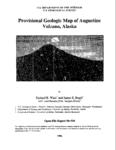Augustine Lahar West of Southeast Point
Start: 1000 yBP ± 100 Years [1]
Stop: 710 yBP ± 50 Years [1]
Event Type: Not an eruption
Description: From Waitt and Beget (1996): "Between about 1000 and 700 yr B.P. (between tephra layers C and M) pyroclastic flows, pyroclastic surges, and lahars swept the west and south flanks."
"A lithic lahar (unit CMl) as thick as 2.5 m poured down a broad paleoswale west of Southeast Point. Similar flows poured across the Jurassic bedrock block and channeled down Middle and East Kamishak Creeks to overtop part of South Point debris-avalanche deposit. At the mouth of Middle Kamishak creek the deposit is eroded back into a sea cliff that descends east from 50 to 30 m high with the slope of the fan surface."
"During this prehistoric period numerous domes must have been emplaced at the summit, repeatedly renewing the source for catastrophic debris avalanches. Remnants of these older domes form the east and south sides of the present summit-dome complex. Below the summit area at least three domes were emplaced on the upper flanks, one on the south (Karnishak dome), two on the northwest (domes "I" and "H'). Another undated and nearly buried dome or lava flow diversifies the upper south flank."
"A lithic lahar (unit CMl) as thick as 2.5 m poured down a broad paleoswale west of Southeast Point. Similar flows poured across the Jurassic bedrock block and channeled down Middle and East Kamishak Creeks to overtop part of South Point debris-avalanche deposit. At the mouth of Middle Kamishak creek the deposit is eroded back into a sea cliff that descends east from 50 to 30 m high with the slope of the fan surface."
"During this prehistoric period numerous domes must have been emplaced at the summit, repeatedly renewing the source for catastrophic debris avalanches. Remnants of these older domes form the east and south sides of the present summit-dome complex. Below the summit area at least three domes were emplaced on the upper flanks, one on the south (Karnishak dome), two on the northwest (domes "I" and "H'). Another undated and nearly buried dome or lava flow diversifies the upper south flank."
References Cited
[1] Volcanic processes and geology of Augustine Volcano, Alaska, 2009
Waitt, R.B., and Beget, J.E., 2009, Volcanic processes and geology of Augustine Volcano, Alaska: U.S. Geological Survey Professional Paper 1762, 78 p., 2 plates, scale 1:25,000, available at http://pubs.usgs.gov/pp/1762/ .[2] Provisional geologic map of Augustine Volcano, Alaska, 1996
Waitt, R. B., and Beget, J. E., 1996, Provisional geologic map of Augustine Volcano, Alaska: U.S. Geological Survey Open-File Report 96-0516, 44 p., 1 plate, scale 1:25,000.[3] Preliminary volcano-hazard assessment for Augustine Volcano, Alaska, 1998
Waythomas, C. F., and Waitt, R. B., 1998, Preliminary volcano-hazard assessment for Augustine Volcano, Alaska: U.S. Geological Survey Open-File Report 98-0106, 39 p., 1 plate, scale unknown.Complete Eruption References
Provisional geologic map of Augustine Volcano, Alaska, 1996
Waitt, R. B., and Beget, J. E., 1996, Provisional geologic map of Augustine Volcano, Alaska: U.S. Geological Survey Open-File Report 96-0516, 44 p., 1 plate, scale 1:25,000.

Preliminary volcano-hazard assessment for Augustine Volcano, Alaska, 1998
Waythomas, C. F., and Waitt, R. B., 1998, Preliminary volcano-hazard assessment for Augustine Volcano, Alaska: U.S. Geological Survey Open-File Report 98-0106, 39 p., 1 plate, scale unknown.

Volcanic processes and geology of Augustine Volcano, Alaska, 2009
Waitt, R.B., and Beget, J.E., 2009, Volcanic processes and geology of Augustine Volcano, Alaska: U.S. Geological Survey Professional Paper 1762, 78 p., 2 plates, scale 1:25,000, available at http://pubs.usgs.gov/pp/1762/ .